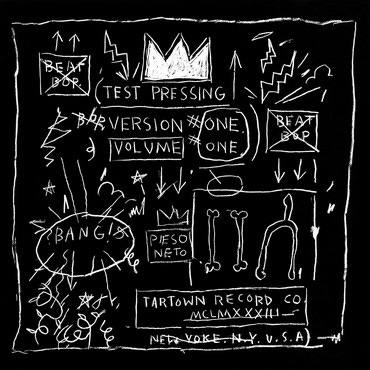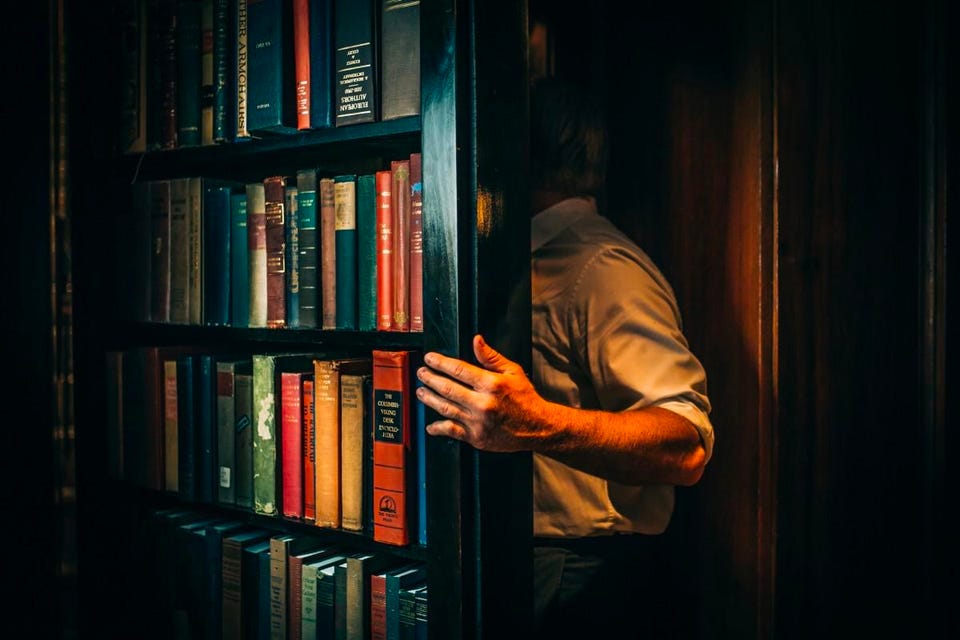🎪 Dear Voyeurs, The Curiosity Gap, Anatomy of Creepy Places, & Objectifying Vampires
Mind your step as you enter the world of chills and thrills
WELCOME TO MIND YOUR STEP - ISSUE 9!
Mindfulness isn’t the only powerful psychological state.
There are so many discussions and studies on the benefits of mindfulness meditation. There’s little doubt that it’s a powerfully beneficial practice.
But its popularity has pushed it into one of my biggest pet peeves — one size fits all solutions.
Assuming that we all have unique goals, points of view, and baseline states of mind, then something like mindfulness meditation is going to have varying effects for each of us.
I want to see more people talking about how they’ve created practices and built environments around other beneficial psychological states.
Let’s expand our toolboxes and broaden the conversation to include practices and places that elicit joy, bliss, flow, wonder, comfort, nostalgia, pronoia, optimism…
There are so many powerful emotions and states of mind. And with a little creativity and intention we can design environments to conjure them.
What are the feelings you’re optimizing for in your life?
Sending my favourite feeling of wonder your way,
Lamar ✌️👽
Mind Your Step is the weekly newsletter to read if you want to empower your inner world builder. At the intersection of environmental psychology, creative design, and imaginative ideation, it’s the go-to source for learning how to design spaces that influence the way people think.
DEAR VOYEURS
The Curiosity Gap: Spaces Designed to Lure our Gaze

Are you allured by the obscured?
Blurred out tinder pics?
Articles under paywalls?
Partially open curtains offering a glimpse into a home?
Where does the curiosity gap hit you the hardest?
The curiosity gap is the distance between what we know and what we want to know.
Remember when the world fell into a frenzy when Willy Wonka’s chocolate factory announced it was opening up its doors to a select few. It’s because of the curiosity gap why everybody wanted in. They bought bundles, and boxes, and buses chalk full of chocolate just for the chance of chipping away at its exclusive veneer.
Obscurity is seductive. And exclusivity is the lingerie of a seductive space.
Places just out of reach are often the ones that pique our urge to sneak a peek behind the scenes.
And it hits some of us harder than others.
Spaces where we’re not supposed to be,
where few have ever been before,
and where only the elite have access.
Those are the ones that get us undressing their exteriors in our minds, trying to imagine what it’s like inside.
It’s not easy to escape the siren song of a space specifically designed to trigger our curiosity gap.
And there’s a barrage of bizarrchitecture out there with that goal in mind.
Weird doors. Unorthodox entrances. Intimidating gatekeepers. All deliberately placed for the purpose of encouraging an atmosphere of allure.
Consider the Upside Down House in Zakopane, Poland.
Or the doorway to any ingenious speakeasy. Like the secret entrance to the Blue Room in Los Angeles.
Or the Krzywy Domek shopping centre in Sopot, Poland.
How hard would the curiosity gap hit you if you passed in front of any of them?
Would you double and then triple and then quadruple take — feeling compelled to take a look inside?
Which windows would you want to stalk if you could snoop behind any curtain in the world?
FEATURED PLACE: THE 13TH FLOOR
Sensing Psychopathy & the Anatomy of Creepy Places
“Please. Don’t do this.”
The manager’s final plea before Mike Enslin entered 1408.
Arguably my favourite horror movie, 1408 feeds into both my love for horror and my obsession with how spaces can mess with our mind.
In last week’s issue, I brushed upon the difference between scary and creepy.
Where some places make us feel afraid, there are others that make us feel uneasy — the "something’s not quite right here" feeling.
Creepiness lingers. It makes our skin crawl.
It got me thinking about the anatomy of a creepy place — what exactly is it in an environment that can give us the heebie jeebies?
I refuse to believe that horror movie characters are inherently as dumb as they act. We try to warn them not to open that closet, and to go somewhere more public, and to believe their friend who clearly has superior instincts. But they rarely listen.
And as much as we like to believe that we’re smarter, our spidey sense isn’t always reliable.
You ever wonder if after we die we’ll get to pan away from our 1st person perspective & rewatch our life on the big screen?
We'd get to observe all the times when we went to a catastrophic event.
We’d watch ourselves open the door to that crappy motel we stayed at that one time in order to save some cash.
We’d shout at ourselves on the screen, “don’t go in there, you idiot. What are you thinking”.
“I would rather trust a woman's instinct than a man's reason.”
― Stanley Baldwin
One of my least favourite tropes in horror movies is the thinker vs the feeler protagonists — where evolution has awarded the feeler with a well honed survival instinct, the clueless thinker looks at them with contempt and always manages to persuade them that they’re irrational.
It’s known as the Cassandra Truth trope.
In Greek mythology, Cassandra was gifted psychic powers by a god who wanted sexual favours in return. But after seeing his dark future, she reneged on their deal. Offended and infuriated, the god then cursed her to live a life full of honest visions that no one would believe.
Just like Cassandra, our gut instincts often fall victim to our curse of logic.
We walk into a place. We feel that something’s off. But because we can’t put our finger on it, we proceed to enter into a den of danger.
Dissecting the anatomy of what makes a place creepy is our way of understanding why we’re likely catching a bad vibe.
Here are 10 elements that make an environment feel creepy.
Temperature drops. A common symptom of exposure to creepiness is getting goosebumps and the chills. In a study conducted in 2012, researchers from the University of Groningen in the Netherlands learned that participants who felt creeped out also tended to feel colder and to believe that the temperature in the room had actually dropped. 🔗 / link / So spaces that can simulate those physical reactions (like those with infrequent temperature fluctuations) might be more likely to give us the creeps.
Sketchy pasts. In 2013, Frank McAndrew, professor of psychology at Knox College in Illinois, and graduate student Sara Koehnke conducted a survey asking more than 1,300 people "what is creepy?" They found that one of the biggest predictors of creepiness was a feeling of unpredictability. There’s a reason realtors are rarely eager to divulge the unnatural deaths that have occurred in a home.
Representations of death. Similar to avoiding conversions around homicide homes, other representations of death tend to creep people out too. Occupations like taxidermists and funeral directors were listed among the creepiest professions in McAndrew and Koehnke’s survey. So spaces with taxidermy aren’t likely to create comforting atmospheres.
Clowns. One profession which usurped taxidermists’ and funeral directors’ creepy crown was clowns. So spaces with clown paraphernalia aren’t likely to be big crowd pleasers either.
Superstition taunts. The Otis Elevator Company reported that 80 to 90% of the elevators they installed in skyscrapers and large hotels omitted the 13th-floor button. If we dig deep we’ll find a bunch of superstitious architecture accommodations for superstitious tenants. So staying in a suite located on the 13th floor or, even worse, in suite 1408 could trigger our dystopian magical thinking.
Non-place loneliness. A common theme found in the creepy genre is a separation from others while they’re still in view. In shows like Courage the Cowardly Dog and movies like 1408, the main characters often find themselves in scenarios where salvation seems just out of reach. They’re on a deserted island with a view of the bustling world around them.
Uncanny familiarity. Some spaces give us that “something is not quite right here” feeling. It’s a similar feeling to what I described in my last issue on The Paradox of Non-Places. “They are the airports, the hospitals, and the malls where we would feel lonely and creeped out if we weren’t surrounded by other people.” They feel familiar, but the something in its context is out of place.
Distant / inaccessible escape. When the exit is all the way across an unfamiliar dark hallway most of us would have to hype ourselves up to find the confidence to start walking.
Surveillance. It’s easy to feel on edge when we’re either being watched or we just think we’re being watched. An old portrait painting whose eyes seem to track us across a room is a sure-fire way to get some goosebumps.
Men. Finally, McAndrew and Koehnke’s survey found that both men and women believed that men were far more likely to be creepy than women. So according to the general population, stick a man in a room and you’ve just upped its chance of feeling creepy 🤷🏽♂️
FEATURED THEORY: ENERGY AURAS
Objectifying Vampires: Finding Motivation by Identifying our Energy Assets & Liabilities
What if we could see our energy levels as aura?
We’d be able to look down at our hands enveloped in their colourful steam and inspect how much energy we have at our disposal.
Now imagine that we could see the energy auras of all the people, objects, and places around us.
We’d start to notice how all of these energies interact with one another.
At any social gathering we’d see the aura seep and deplete from all the introverts. We’d observe our energy spill into our comfy couches. Fading our aura into transparent nothingness until we fall asleep. And feeding our sofa’s energy aura until it matches our body heat.
Some items fuel us. Those are our energetic assets: cute mugs, fun deco…
Others suck our life right out of us. Our lethargic liabilities: dirty laundry, unfinished books…
Which object vampires have you accidentally invited into your space?
RECOMMENDED VIDEO
“With AR, now the entire world is a theme park. I experience this when my son and I play Pokemon GO. Our reality has expanded to accommodate an entire world filled with Pokemon. And for us, that's not fantasy, it's just an expansion of our reality.
So picture a scenario where everyone had something in their life, like Pokemon GO. You could live in the Pokemon or the Harry Potter wizarding world, Marvel or the DC Universe or it could be Victorian or '50s Americana or Western. Your entire fantasy world connected by AR, VR, movies, television, theme parks…”
CHALLENGE WORTH TRYING
Project Place Personification
Simple hack for making a house feel like a home: Name it.
Silicon Valley evokes innovation.
Sailers name their ships.
Motorheads name their cars.
Research suggests we value & appreciate objects more when we name them.
Names are our tool for encapsulating value into our spaces.
ENJOYED THIS ISSUE?
Research shows that people who click the ❤️ button are the least creepy people in the world 👀











Well this issue has definitely sparked my curiosity and it's going to make me think twice when I get curious about something that "doesn't quite feel right" 😨🤔 I might just decide to deny my curiosity about whatever "it" is 🤫 and prefer to stay behind a "safe" ignorance bliss cloud 😶🌫️